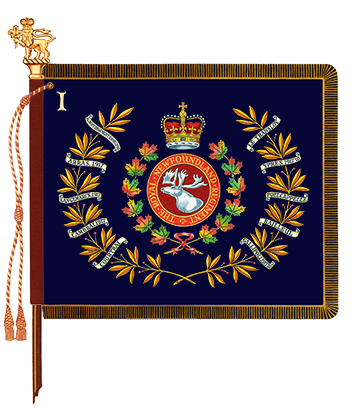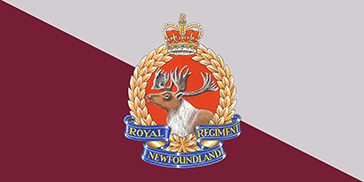The Royal Newfoundland Regiment
The official lineage of The Royal Newfoundland Regiment infantry regiment.

Colonel-in-Chief: Her Royal Highness The Princess Anne The Princess Royal LG LT GCVO QSO GCL CD FRS
Badge
Description
Gules a caribou's head and neck proper all within a wreath of laurel Or ensigned by the Royal Crown proper and set on a scroll Azure inscribed ROYAL NEWFOUNDLAND REGIMENT in letters Or.
Symbolism
The Crown represents service to the Sovereign. The laurel wreath, which symbolizes excellence and achievement, dates back to competitions and combat in ancient Greek times. The woodland caribou head is based on the badge of The Royal Newfoundland Regiment of the First World War and which itself was copied from that of the Newfoundland Highlanders, a para-military cadet corps formed in 1907. The claret background was one of the First World War regiment's livery colours, the other being white. "ROYAL NEWFOUNDLAND REGIMENT" is a form of the regimental title.
Motto
None
March
"The Banks of Newfoundland"
Alliance
British Army
The Royal Regiment of Scotland
Australian Army
The Royal New South Wales Regiment
Regimental colour

Camp flag

Battle honours
The War of 1812
DEFENCE OF CANADA – 1812-1815 – DÉFENSE DU CANADA; DETROIT; MAUMEE (all three honours awarded in commemoration of the Royal Newfoundland Fencible Infantry)
The First World War
SOMME, 1916; Albert (Beaumont Hamel), 1916; Le Transloy; ARRAS, 1917; Scarpe, 1917; YPRES, 1917, 18; Langemarck, 1917; Poelcappelle; CAMBRAI, 1917; LYS; Bailleul; Kemmel; COURTRAI; FRANCE AND FLANDERS, 1916-18; GALLIPOLI, 1915-16; EGYPT, 1915-16.
Lineage
This Reserve Force regiment originated on 24 October 1949 and incorporates the following regiments
The Royal Newfoundland Regiment originated in St. John's, Newfoundland and Labrador on 24 October 1949, when 'The Newfoundland Regiment, RCIC' was authorized to be formed.Footnote 1 It was redesignated 'The Royal Newfoundland Regiment, RCIC' on 14 December 1949.Footnote 2 On 1 March 1961, it was amalgamated with the '166th (Newfoundland) Field Artillery Regiment, RCA' (see below), and redesignated 'The Royal Newfoundland Regiment'.Footnote 3
Notes:
On 28 March 1974, it was organized as a two battalion regiment, consisting of the 1st Battalion with "D", "E" and "F" companies and the 2nd Battalion with "A" and "B" companies (Message, NDHQ DOE 261500Z MAR 74).
On 12 August 1977, all generic titles in the Canadian Forces, such as 'battalion', were made bilingual (Memorandum, DGBB (Director General Bilingualism and Biculturalism), 1901-1/1211-7-4, 12 Aug 77).
On 15 June 1926, the 1st Battalion was redesignated the 1st Battalion (4th Battalion, CEF) (GO 57/26). The reserve units were disbanded on 14 December 1936 (GO 3/37).
The '166th (Newfoundland) Field Artillery Regiment, RCA' originated in St. John's, Newfoundland and Labrador on 24 October 1949, when the '166th (Newfoundland) Field Regiment, RCA' was authorized to be formed.Footnote 4 It was redesignated the '166th (Newfoundland) Field Artillery Regiment, RCA' on 12 April 1960.Footnote 5 On 1 March 1961, it was amalgamated with 'The Royal Newfoundland Regiment, RCIC', as above.
Perpetuations
'The Royal Newfoundland Regiment', 1914 1919
Headquarters Location
1st Battalion: St. John's, Newfoundland and Labrador
2nd Battalion: Corner Brook, Newfoundland and Labrador
Operational history
The First World War
On 4 September 1914, the Legislative Assembly of Newfoundland passed an Act authorizing the formation of a corps for war service. This is considered to be the official date of formation of 'The Royal Newfoundland Regiment' of 1914-1919.Footnote 6 The first contingent, consisting of a headquarters and two companies, embarked for Britain on 3 October 1914.Footnote 7 In February 1915, when through the addition of a second contingent from Newfoundland, it reached battalion strength and was designated the '1st Newfoundland Regiment'.Footnote 8 It was redesignated 'The Royal Newfoundland Regiment' on 25 January 1918.Footnote 9 On the night of 19 September 1915, the battalion landed at Suvla Bay on the Gallipoli Peninsula, Turkey, as part of the 88th Infantry Brigade, 29th Division.Footnote 10 The battalion fought in the Dardanelles campaign until 9 January 1916, and after a brief period spent in Egypt, landed in France on 22 March 1916, as part of the 88th Brigade. On 13 September 1918 it was allocated to the 28th Infantry Brigade, 9th (Scottish) Division, with whom it continued to fight in France and Flanders until the end of the war.Footnote 11 The regiment was disbanded on 26 August 1919.Footnote 12
The Second World War
Notes:
The regiment has no direct link with military activity in Newfoundland during The Second World War. However, a volunteer force was recruited in Newfoundland in 1939. It was divided into active and part-time components respectively designated the Newfoundland Militia and Newfoundland Auxiliary Militia or Home Guard. In March 1943 the active force was redesignated the Newfoundland Regiment, and the Home Guard became the Newfoundland Militia. The Newfoundland forces, which also included a Coastal Defence Battery on Bell Island, carried out guard duty at vulnerable points and also acted as a training depot for volunteers for the two Royal Artillery Regiments.Footnote 13
The 166th (Newfoundland) Field Artillery Regiment, RCA has no lineal connection with, but may be assumed to be heir to the traditions of the two artillery regiments composed of Newfoundland personnel which served in the British Army; namely, the '166th (Newfoundland) Field Regiment, RA' which served in Britain, North Africa and Italy (authorized as the '57th Heavy Regiment, RA' on 8 April 1940, redesignated 15 November 1941 and disbanded 31 October 1945) and the '59th (Newfoundland) Heavy Regiment, RA', which served in Britain and North-West Europe (authorized 15 June 1940 and disbanded 31 August 1945).Footnote 14
Page details
- Date modified: